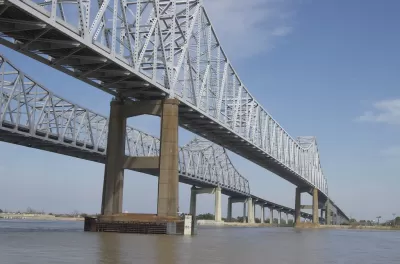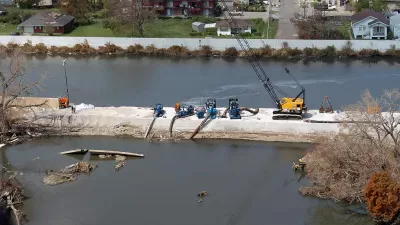Climate change and channelization have made high water levels the norm along the river. But low-lying New Orleans lies in its path, and the consequences could be monumental.

Henry Grabar writes about the rising of the Mississippi River and the threats it poses in southern Louisiana, and particularly to New Orleans. "America’s wettest 12-month period in recorded history, all those devastating floods in Nebraska, Iowa, Oklahoma, Arkansas … it is all coming down through New Orleans now, putting the world’s most ambitious infrastructure of river control to the test."
The river is setting high water records—it is eight feet higher now than it was at this time last year—and the result has been large amounts of very fast-moving water, making navigation of vessels dangerous and travel upstream slow and difficult.
The combination of weather and channelization to keep the river under control has experts worried, says Grabar. The constant stress on the aging levee system could weaken it. And the approach of hurricane season when the river is so high is a concern.
"A storm would have to hit the river mouth just so to cause a major river surge. But as the years go by, it is looking more likely that high water and a hurricane could coincide—and in turn, it becomes more important to rethink the logic of the system that sends so much water through New Orleans into the hot summer months," notes Grabar.
FULL STORY: Hell Is High Water

Study: Maui’s Plan to Convert Vacation Rentals to Long-Term Housing Could Cause Nearly $1 Billion Economic Loss
The plan would reduce visitor accommodation by 25,% resulting in 1,900 jobs lost.

North Texas Transit Leaders Tout Benefits of TOD for Growing Region
At a summit focused on transit-oriented development, policymakers discussed how North Texas’ expanded light rail system can serve as a tool for economic growth.

Why Should We Subsidize Public Transportation?
Many public transit agencies face financial stress due to rising costs, declining fare revenue, and declining subsidies. Transit advocates must provide a strong business case for increasing public transit funding.

How to Make US Trains Faster
Changes to boarding platforms and a switch to electric trains could improve U.S. passenger rail service without the added cost of high-speed rail.

Columbia’s Revitalized ‘Loop’ Is a Hub for Local Entrepreneurs
A focus on small businesses is helping a commercial corridor in Columbia, Missouri thrive.

Invasive Insect Threatens Minnesota’s Ash Forests
The Emerald Ash Borer is a rapidly spreading invasive pest threatening Minnesota’s ash trees, and homeowners are encouraged to plant diverse replacement species, avoid moving ash firewood, and monitor for signs of infestation.
Urban Design for Planners 1: Software Tools
This six-course series explores essential urban design concepts using open source software and equips planners with the tools they need to participate fully in the urban design process.
Planning for Universal Design
Learn the tools for implementing Universal Design in planning regulations.
City of Santa Clarita
Ascent Environmental
Institute for Housing and Urban Development Studies (IHS)
City of Grandview
Harvard GSD Executive Education
Toledo-Lucas County Plan Commissions
Salt Lake City
NYU Wagner Graduate School of Public Service




























